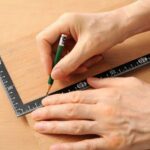Woodwork can add warmth and character to any space, but layers of old paint can diminish its natural beauty. If you’re looking to restore and enhance your woodwork, removing these layers of paint is essential. In this article, we will guide you through the process of safely and effectively removing paint from woodwork.
Multiple layers of paint not only detract from the aesthetics of woodwork but also lead to a range of common issues such as peeling, cracking, and uneven surfaces. With each new layer applied, the original details and grain of the wood become obscured. By removing these old layers, you can reveal the true beauty hidden beneath and breathe new life into your woodwork.
Before diving into the removal process, it is important to assess the scope of your project. Determine what types of woodwork you will be working on, evaluate the condition and number of paint layers, and identify any underlying issues such as lead-based paint or previous repairs. This assessment will help you determine the appropriate tools and materials needed for success.
By understanding why it’s necessary to remove layers of paint from woodwork and knowing how to properly assess your project’s scope, you will be well-prepared for the next steps in restoring your materials. In the following sections, we will discuss choosing the right tools and materials, preparing the area for work, various manual paint removal techniques, heat gun methods, chemical stripping processes, sanding and finishing techniques.
So let’s get started on bringing out the natural beauty in your woodwork.
Assessing the Woodwork
When embarking on a project to remove layers of paint from woodwork, it is crucial to first assess the scope of the task at hand. By understanding the extent and condition of the woodwork, you can better plan and execute an effective paint removal process. This section will guide you through the important steps of assessing your woodwork.
Firstly, determine what type of woodwork you will be stripping. Whether it’s doors, cabinets, trim, or other wooden surfaces, each may require different approaches or tools for paint removal. Additionally, evaluating the number of paint layers is essential in preparing for the project. Multiple layers may make the removal process more time-consuming and challenging.
It is crucial to identify any underlying issues before proceeding with paint removal. If your woodwork was painted prior to 1978, there’s a possibility that lead-based paint was used. In such cases, extra precautions must be taken to ensure safety while removing the old layers. Furthermore, if there have been previous repairs or alterations to the woodwork, these areas might require special attention during the removal process.
To assist you in determining your project’s scope accurately, create a checklist or visual inspection plan as a useful tool for documenting and organizing information about each piece of woodwork that needs attention. This will help you stay organized throughout the project and ensure no step is overlooked.
Assessing your woodwork thoroughly sets a solid foundation for an effective paint removal process. With this understanding of its scope and condition in place, you can move forward confidently in choosing suitable methods and materials for safely and efficiently removing layers of paint from your woodwork.
- Evaluate type of woodwork (doors, cabinets, trim).
- Determine number of paint layers.
- Identify any underlying issues (lead-based paint or previous repairs).
Choosing the Right Tools and Materials
Choosing the right tools and materials is essential when it comes to removing layers of paint from woodwork. Having the appropriate tools will make the process more efficient and effective, ensuring that you achieve the desired results without causing damage to the woodwork. Additionally, using the right materials will help you protect yourself and the surrounding environment during the paint removal process.
There are several essential tools that you will need for paint removal from woodwork. These include a scraper, a heat gun, a chemical stripper, and sandpaper. A scraper is useful for physically scraping off layers of paint from the wood surface. It is important to choose a scraper with a sharp blade or multiple blades for effective removal. A heat gun can be used to soften and loosen layers of paint, making it easier to scrape them off.
Chemical strippers can also be effective in removing multiple layers of paint. They work by breaking down the bonds between the paint and the wood surface, making it easier to remove with a scraper or sandpaper. When using chemical strippers, it is important to wear gloves, goggles, and a dust mask to protect yourself from any potential hazards.
In addition to tools, it is important to choose suitable paint strippers for different types of woodwork and paint layers. There are various types of chemical strippers available in the market, each designed for specific purposes. Some are better suited for thick or stubborn layers of paint, while others are more gentle and eco-friendly. It is important to read product labels and choose strippers that are appropriate for your specific project.
By choosing the right tools and materials for removing layers of pain from woodwork, you can ensure a successful restoration process while minimizing any potential risks or damage.
Preparation
Clearing and protecting the surrounding area is an important step in the process of removing layers of paint from woodwork. Without proper preparation, the removal process can result in a messy and potentially damaging experience. Here are some essential steps to follow for preparing the area before starting the paint removal:
- Remove Furniture and Coverings: Before starting the paint removal process, it is crucial to clear the area of any furniture or items that may obstruct or get in the way. Move all nearby furniture, décor, and other belongings out of the workspace to prevent any accidental damage or contamination with paint chips or dust. Additionally, remove any coverings such as rugs or curtains that could be affected by paint particles.
- Protect Floors, Walls, and Adjacent Surfaces: It is vital to protect floors, walls, and adjacent surfaces from potential damage during the paint removal process. Cover the floor with drop cloths or plastic sheets to catch any falling debris or drips.
Secure the protective covering with tape along its edges to ensure it stays in place throughout the project. Use painter’s tape to protect walls, trims, and moldings from accidental contact with paint strippers or scraping tools. - Ventilation: Proper ventilation is essential when working with chemicals or heat-generating tools during the paint removal process. Open windows and doors to allow fresh air circulation and reduce fumes within the workspace. If working in an enclosed area without adequate ventilation options, consider using fans or portable ventilators to improve air circulation.
By following these preparatory steps, you can create a safe and organized environment for removing layers of paint from woodwork. Taking these precautions will help protect your surroundings from potential damage while ensuring a smooth and efficient restoration process.
- Remove furniture and coverings
- Protect floors, walls, and adjacent surfaces
- Ensure proper ventilation
Manual Paint Removal Techniques
When it comes to removing layers of paint from woodwork, there are several manual techniques that can be employed. These methods require physical effort but can be effective in getting rid of unwanted layers of paint without the use of chemicals or heat. The three most common manual paint removal techniques are scraping, sanding, and abrasive blasting.
- Scraping: Scraping is a straightforward method that involves using a scraper tool to manually remove the paint from the woodwork. Before starting, ensure you have a sharp scraper with a comfortable grip for better control and efficiency. Begin by positioning the scraper at an angle against the painted surface and applying pressure as you push it along to remove the paint. Work systematically, section by section, until you have removed all the unwanted layers of paint.
- Sanding: Sanding is another popular technique for removing paint layers manually. Start by using coarse-grit sandpaper to roughen up the painted surface and create better adhesion for subsequent layers of sandpaper.
Progressively move on to finer grit sandpapers as you work your way towards achieving a smooth surface free from any residual paint or imperfections. Remember to wear protective gear such as goggles and a dust mask when sanding to minimize health risks associated with inhaling fine particles. - Abrasive Blasting: Abrasive blasting, also known as media blasting or sandblasting, involves propelling small abrasive materials against the painted woodwork using compressed air or high-pressure water. This technique is especially useful for large items or stubborn areas where manual scraping may be time-consuming or challenging. It effectively removes multiple layers of paint but requires some expertise and specialized equipment.
| Technique | Description |
|---|---|
| Scraping | Using a scraper tool to manually remove paint |
| Sanding | Roughening up the painted surface with sandpaper |
| Abrasive Blasting | Propelling abrasive materials against the paint using compressed air or high-pressure water |
It is essential to exercise caution and patience when employing manual paint removal techniques to avoid damaging the underlying woodwork. Take your time, follow proper procedures, and consider seeking professional help for delicate projects or intricate woodwork designs. By choosing the appropriate manual technique for your specific needs, you can effectively remove layers of paint and restore the natural beauty of your woodwork.
Heat Gun Method
The heat gun method is a popular and effective technique for removing layers of paint from woodwork. Using heat to soften the paint allows for easy scraping and removal, resulting in a clean and smooth surface. This section will discuss the benefits of using a heat gun, the process of using it to remove paint layers, as well as important safety precautions.
The Benefits of Using a Heat Gun
Using a heat gun for paint removal offers several advantages. Firstly, it is a versatile tool that can be used on various types of woodwork, including doors, cabinets, and trim. The heat gun’s adjustable temperature settings allow you to control the intensity of the heat based on the type and thickness of the paint layers.
Additionally, compared to other methods such as scraping or chemical stripping, using a heat gun tends to be faster and more efficient. The heat softens the paint quickly, making it easier to scrape off in large sections rather than meticulously removing small bits at a time. This can save you significant time and effort during your project.
The Process of Using a Heat Gun
When using a heat gun for paint removal, it’s important to follow proper procedures to achieve optimal results without damaging the woodwork. Here is a step-by-step guide:
- Prepare the work area: Clear any furniture or items that may obstruct your access to the woodwork. Protect surrounding surfaces with drop cloths or plastic sheets.
- Safety first: Before starting, ensure you are wearing appropriate safety equipment such as gloves, goggles, and a dust mask to protect yourself from fumes and debris generated during the process.
- Set up your workspace: Position yourself comfortably with good visibility of the woodwork. Plug in your heat gun and set it to an initial low temperature setting.
- Test on an inconspicuous area: Before applying heat directly onto visible areas, test on an inconspicuous section of the woodwork to determine the ideal temperature setting that will soften the paint without scorching or burning.
- Apply heat to small sections: Once you’ve found the appropriate temperature, hold the heat gun about 2-3 inches away from the painted surface and move it in a slow and steady motion. Apply heat to small sections at a time, allowing the paint to soften and bubble.
- Scrape off softened paint: As the paint starts to bubble, immediately use a scraper (preferably made of metal) to gently scrape off the softened layers. Work in one direction to avoid scratching or gouging the woodwork.
- Repeat if necessary: If there are multiple layers of paint, you may need to repeat the process until all layers have been removed.
Safety Precautions and Risks
While using a heat gun can be an effective method for removing paint layers, it’s important to take safety precautions and understand potential risks associated with its use. Proper ventilation is crucial as using a heat gun can release fumes. Make sure you are working in a well-ventilated area or use fans or exhaust systems to minimize exposure.
Take care not to overheat the woodwork as this can lead to scorching or burning, which may damage its appearance. Always keep a safe distance between the heat gun and the painted surface, constantly moving it back and forth in a controlled manner.
Lastly, be cautious when working with lead-based paints as they can release toxic fumes when heated. Use appropriate protective gear such as an N95 respirator mask specifically designed for lead dust protection.
By following these guidelines and safety measures, you can confidently use a heat gun for removing paint layers from your woodwork effectively and safely.
Chemical Paint Stripping
Chemical paint stripping is a popular and effective method for removing layers of paint from woodwork. While it may not be suitable for all situations, it offers advantages in terms of efficiency and effectiveness. This section will discuss the advantages and disadvantages of using chemical strippers, detail the application process, and offer recommendations for eco-friendly or less toxic options.
Advantages and Disadvantages
Chemical strippers offer several advantages when it comes to removing paint layers from woodwork. Firstly, they are generally more efficient than manual techniques such as scraping or sanding. Chemical strippers can penetrate multiple layers of paint, making the removal process quicker and easier. They also work well on intricate details or hard-to-reach areas that may be challenging to scrape manually.
However, there are some downsides to consider when using chemical strippers. One disadvantage is that they can be messy and require careful handling. Many chemical strippers contain harsh chemicals that emit strong fumes, so proper ventilation and protective equipment are necessary to ensure personal safety during the stripping process. Additionally, some chemical strippers have a long dwell time requirement, which means you may need to wait extended periods before being able to remove the softened paint.
Application Process
When applying chemical strippers, it’s crucial to follow the instructions provided by the manufacturer carefully. Typically, the process involves brushing or spraying the stripper onto the woodwork’s surface in an even coat. The product needs time to soften or dissolve the paint layers before they can be scraped off.
After allowing sufficient dwell time as instructed by the manufacturer, use a scraper or putty knife to gently remove the softened paint. It’s essential to work in small sections at a time to prevent drying or rehardening of the stripper on the woodwork’s surface. Use a cloth or sponge dampened with water or neutralizing solution recommended by the manufacturer to clean off any remaining residue.
Eco-Friendly and Less Toxic Options
For those concerned about the environmental impact or potential health risks of using traditional chemical strippers, there are eco-friendly and less toxic alternatives available. These options use naturally derived ingredients or have less harmful chemicals that are safer for both the user and the environment.
Look for paint strippers labeled as “eco-friendly,” “biodegradable,” or “low odor.” These products typically contain natural solvents, such as citrus-based extracts or soybean oil. While they may take slightly longer to work compared to their stronger chemical counterparts, they offer a greener alternative without compromising effectiveness.
Sanding and Finishing
The process of sanding and finishing is a crucial step in achieving a smooth and flawless surface after removing layers of paint from woodwork. Once the old paint layers have been stripped away, there may still be residue or imperfections on the wood surface that need to be addressed. This section will guide you through the necessary steps to ensure a polished and even finish.
Before starting the sanding process, it is important to gather the right tools and materials. You will need sandpaper of various grits, ranging from coarse to fine, depending on the condition of the woodwork. Coarser grits should be used for initial sanding to remove any remaining paint residue or rough spots, while finer grits are used for final smoothing and polishing.
To start, use a coarser grit sandpaper (around 80 or 100) and sand in the direction of the wood grain. This will help remove any leftover paint particles or stubborn areas. As you progress with finer grits (such as 150 or 220), gradually switch to a circular motion to achieve an even smoother surface.
It is essential to pay attention to detail during this process, ensuring that all surfaces are sanded evenly and thoroughly. Take your time and inspect the woodwork closely after each round of sanding to identify any missed spots or imperfections.
Once you have achieved a smooth surface, it is recommended to use a tack cloth or vacuum cleaner to remove any dust particles before applying any finishes or topcoats. Depending on your desired outcome, you can choose from various finishes such as varnish, stain, or paint. These coatings not only protect but also enhance the appearance of your restored woodwork.
By following these steps for sanding and finishing, you can achieve beautifully restored woodwork that adds value and charm to your living space. The effort put into this final stage will result in furniture pieces, cabinets, doors, or trim that are ready to be enjoyed for years to come.
Conclusion
In conclusion, removing layers of paint from woodwork is a crucial step towards restoring and enhancing the natural beauty of the wood. Through this process, homeowners can address common issues such as peeling, cracking, and uneven surfaces caused by multiple layers of paint. By following the outlined steps, individuals can transform their woodwork into stunning focal points within their living spaces.
Assessing the woodwork and understanding the scope of the project is essential before starting the paint removal process. This involves determining the type of woodwork to be stripped and evaluating the condition and number of paint layers. Identifying any underlying issues such as lead-based paint or previous repairs is also crucial for ensuring safety and achieving desired results.
Choosing the right tools and materials for paint removal is vital for an efficient and effective process. Essential tools such as scrapers, heat guns, chemical strippers, and sandpaper should be carefully selected based on the type of woodwork and paint layers being removed. Equipping oneself with appropriate safety equipment like gloves, goggles, and a dust mask is equally important to protect against any potential hazards.
By taking these necessary steps to remove layers of paint from woodwork, individuals can rejuvenate their living spaces and add value to their homes. The refreshed woodwork will not only enhance aesthetics but also provide a sense of pride in showcasing a beautifully restored piece. So don’t hesitate to embark on this rewarding journey – start removing those layers of paint today.
Frequently Asked Questions
What is the best way to remove layers of paint from wood?
The best way to remove layers of paint from wood is by using a combination of heat, solvents, and scraping. One effective method is heat stripping, which involves using a heat gun or infrared heater to soften the paint, making it easier to scrape off. However, it’s important to exercise caution and follow safety guidelines when using heat sources to avoid the risk of fire or damaging the wood.
Another option is using chemical paint strippers that are specifically designed for wood surfaces. These products break down the chemical bond between the paint layers and the wood, allowing them to be scraped off more easily. After applying the stripper according to the manufacturer’s instructions, use a scraper or putty knife to gently remove the layers of softened paint.
How do you remove multiple layers of paint from wood?
Removing multiple layers of paint from wood requires patience and thoroughness. Start by testing an inconspicuous area with different methods like scraping, sanding, or using chemical strippers to determine which works best for your particular situation. Scraping can be done manually with a scraper or putty knife, but this method may not always remove all layers completely.
Sanding can also work well for removing multiple layers of paint by gradually sanding away each layer until reaching bare wood. When using chemical strippers, apply them generously following the product instructions and allow sufficient dwell time before carefully scraping off softened paint layers with a putty knife or scraper. Whichever method you choose, be prepared for multiple passes and repeat applications as necessary until achieving the desired results.
How do you remove paint layers from trim?
When removing paint layers from trim, it’s important to take care in order to preserve its delicate features and intricate designs. Start by protecting surrounding areas with masking tape or plastic sheeting to prevent accidental damage while working on the trim. There are several methods you can use depending on your preference and the type of trim you have. For small areas or intricate details, consider using a chemical gel stripper that can be applied to the trim’s surface and left to soften the paint layers. Once softened, use a scraper or brush to carefully remove the paint without damaging the trim.
Sanding can also be effective for removing paint layers from trim, but it requires finesse and attention to detail. Choose fine-grit sandpaper and proceed slowly, checking your progress frequently to avoid over-sanding. In some cases, a combination of chemical stripping and sanding may be necessary. Whichever method you choose, be patient and work gently to avoid any damage to the trim.

Hi everyone! I’m a woodworker and blogger, and this is my woodworking blog. In my blog, I share tips and tricks for woodworkers of all skill levels, as well as project ideas that you can try yourself.





